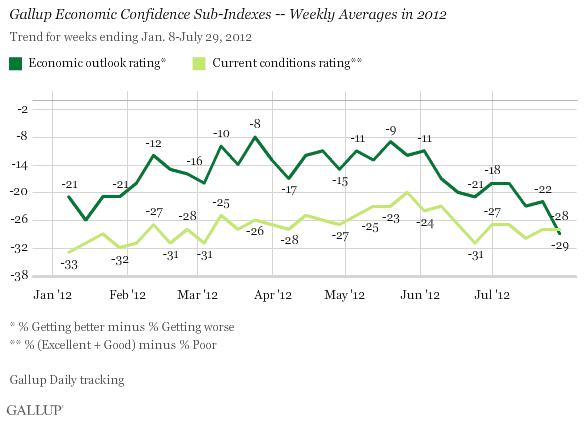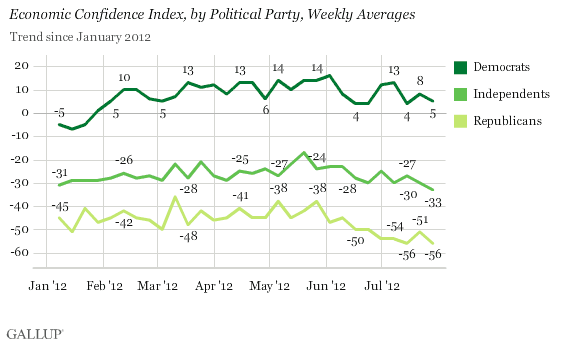WASHINGTON, D.C. -- Americans' confidence in the economy declined last week to -29, matching levels not seen since early January. The decline may be due to the estimate of slower-than-hoped second quarter GDP growth. Confidence had peaked at -16 in late May after a series of encouraging jobs reports, but when subsequent reports were less positive, Americans' confidence headed in the opposite direction. Still, confidence is higher now than it was in the latter part of 2011.

The Gallup Economic Confidence Index is an average of two components of consumers' psychology: Americans' ratings of current economic conditions and their perceptions of whether the economy is getting better or getting worse. The economic outlook component of the index accounted for the overall change in economic confidence, declining seven percentage points to -29 over the past week. Sixty-two percent of Americans now say the economy is getting worse, while 33% say it is getting better. Americans' perceptions of current economic conditions are unchanged at -28, with 14% saying conditions are excellent or good and 42% saying poor.
For most of the year, Americans have been less negative about the economy's direction than about current conditions, but now the two are rated similarly.

Confidence declined last week across all political parties. Confidence among Republicans declined to -56, erasing all gains made the previous week, and among independents, it slipped to -33. These are the lowest confidence readings of 2012 for both Republicans and independents. Democrats are also less confident than they were a week ago, but at +5, their level of confidence is still an improvement over their negative ratings in early January.

The wide party gaps are explained in large part by the fact that the majority of Democrats (55%) feel that the economy is getting better, while the majority of Republicans (83%) and independents (63%) say it is getting worse.
Implications
Economic confidence has not been able to maintain the positive momentum seen during the first half of 2012. As the U.S. government's unemployment rate fell in late 2011 and early 2012, economic confidence improved. However, in recent months, unemployment has been stuck around 8.2% and the economy shows little sign of significantly improving in the near future.
Americans may sense the lack of positive momentum, reflected in the growing majority opinion that the economy is getting worse, and thus, their confidence is declining. Democrats alone are somewhat upbeat in this regard, indicating that they feel the current administration still has the ability to turn the economic situation around. The jobs report that the U.S. Bureau of Labor Statistics releases on Friday will likely play an important role in economic confidence in August. If it is positive, it may counteract the disappointing GDP report. However, if it is negative, it may send economic confidence further downward.
Gallup.com reports results from these indexes in daily, weekly, and monthly averages and in Gallup.com stories. Complete trend data are always available to view and export in the following charts:
Daily: Employment, Economic Confidence, Job Creation, Consumer Spending
Weekly: Employment, Economic Confidence, Job Creation, Consumer Spending
Read more about Gallup's economic measures.
View our economic release schedule.
Survey Methods
Results are based on telephone interviews conducted as part of Gallup Daily tracking from July 23-29, 2012, with a random sample of 2,941 adults, aged 18 and older, living in all 50 U.S. states and the District of Columbia, selected using random-digit-dial sampling.
For results based on the total sample of national adults, one can say with 95% confidence that the maximum margin of sampling error is ±2 percentage points.
Interviews are conducted with respondents on landline telephones and cellular phones, with interviews conducted in Spanish for respondents who are primarily Spanish-speaking. Each sample includes a minimum quota of 400 cell phone respondents and 600 landline respondents per 1,000 national adults, with additional minimum quotas among landline respondents by region. Landline telephone numbers are chosen at random among listed telephone numbers. Cell phone numbers are selected using random-digit-dial methods. Landline respondents are chosen at random within each household on the basis of which member had the most recent birthday.
Samples are weighted by gender, age, race, Hispanic ethnicity, education, region, adults in the household, and phone status (cell phone only/landline only/both, cell phone mostly, and having an unlisted landline number). Demographic weighting targets are based on the March 2011 Current Population Survey figures for the aged 18 and older non-institutionalized population living in U.S. telephone households. All reported margins of sampling error include the computed design effects for weighting and sample design.
In addition to sampling error, question wording and practical difficulties in conducting surveys can introduce error or bias into the findings of public opinion polls.
For more details on Gallup's polling methodology, visit www.gallup.com.
